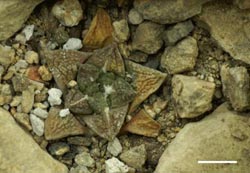Can cacti 'escape' underground in high temperatures?

A \"living rock\" cactus (Ariocarpus fissuratus) in a large container on the roof of the biology building of Occidental College, Los Angeles, in June 2008 after 8 days of high temperatures. This particular plants was embedded in sandy soil with surface rocks. Scale bar = 10 mm. Credit: Gretchen B. North, Occidental College, Los Angeles<br>
In the scorching summer heat of the Chihuahuan Desert in southwest Texas, air temperatures can hover around 97°F (36°C) while at the surface of the soil temperatures can exceed 158°F (70°C).
Encountering these extreme temperatures, plants must utilize creative methods to not only survive but thrive under these difficult and potentially lethal conditions.
This new work by Dr. Gretchen North and colleagues, published in the December issue of American Journal of Botany (http://www.amjbot.org/cgi/reprint/ajb.1000286v1), sheds light on how one desert resident, the cactus Ariocarpus fissuratus, copes with the effects of high temperatures.
“One crucial point is that small desert plants such as the 'living rock' cactus occupy one of the hottest habitats on earth, the surface of desert soils” stated North.
Ariocarpus fissuratus earned its nickname “living rock” because it blends into the rocky surroundings with its small stature that is level with the soil's surface. The researchers hypothesized that the cactus could “escape” high temperatures by moving more of itself below the soil surface where it is cooler.
Measuring changes in plant depth and root anatomy, North and co-workers determined that the cactus moves deeper into the soil by contracting its roots. But does root contraction play a protective role by modulating temperatures?
To find out, the researchers mimicked summer desert conditions by growing plants on a rooftop in Los Angeles, where air temperature was above 99°F for several days. All the cacti were grown in sandy soil, but half had rocks covering the surface of the soil, similar to their native habitats. For plants grown in rocky soils, the internal temperature of the stem was about 39°F lower than those grown in sandy soils alone. While this may seem like a small decrease, it had a significant effect on the health of the plants.
Unlike the cacti grown in sandy soil which all died, those grown in rocky soil survived the intense heat. Root contraction aided in lowering the internal stem temperature, but only when combined with the cooling effects of the rocky surface. The opposite was true in sandy soil where cacti planted higher above the surface had slightly lower stem temperatures than those planted close to the surface.
“Even in rocky soil, experimental plants attained nearly lethal temperatures during a summer heat wave in Los Angeles” said North. “Thus, root contraction and rocky microhabitats may not provide enough protection should desert temperatures get much higher due to global warming.
CITATION: Tadao Y. Garrett, Cam-Van Huynh, and Gretchen B. North (2010). Root contraction helps protect the “living rock” cactus Ariocarpus fissuratus from lethal high temperatures when growing in rocky soil. American Journal of Botany 97(12): 1951-1960. DOI: 10.3732/ajb.1000286
The full article in the link mentioned is available for no charge for 30 days following the date of this summary at http://www.amjbot.org/cgi/reprint/ajb.1000286v1. After this date, reporters may contact Richard Hund at ajb@botany.org for a copy of the article.
The Botanical Society of America (www.botany.org) is a non-profit membership society with a mission to promote botany, the field of basic science dealing with the study and inquiry into the form, function, development, diversity, reproduction, evolution, and uses of plants and their interactions within the biosphere. It has published the American Journal of Botany (www.amjbot.org) for nearly 100 years. In 2009, the Special Libraries Association named the American Journal of Botany one of the Top 10 Most Influential Journals of the Century in the field of Biology and Medicine.
For further information, please contact the AJB staff at ajb@botany.org.
Media Contact
More Information:
http://www.botany.orgAll latest news from the category: Life Sciences and Chemistry
Articles and reports from the Life Sciences and chemistry area deal with applied and basic research into modern biology, chemistry and human medicine.
Valuable information can be found on a range of life sciences fields including bacteriology, biochemistry, bionics, bioinformatics, biophysics, biotechnology, genetics, geobotany, human biology, marine biology, microbiology, molecular biology, cellular biology, zoology, bioinorganic chemistry, microchemistry and environmental chemistry.
Newest articles

Superradiant atoms could push the boundaries of how precisely time can be measured
Superradiant atoms can help us measure time more precisely than ever. In a new study, researchers from the University of Copenhagen present a new method for measuring the time interval,…

Ion thermoelectric conversion devices for near room temperature
The electrode sheet of the thermoelectric device consists of ionic hydrogel, which is sandwiched between the electrodes to form, and the Prussian blue on the electrode undergoes a redox reaction…

Zap Energy achieves 37-million-degree temperatures in a compact device
New publication reports record electron temperatures for a small-scale, sheared-flow-stabilized Z-pinch fusion device. In the nine decades since humans first produced fusion reactions, only a few fusion technologies have demonstrated…





















